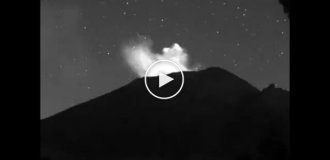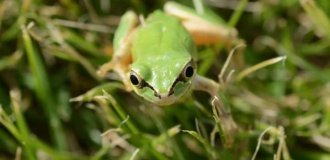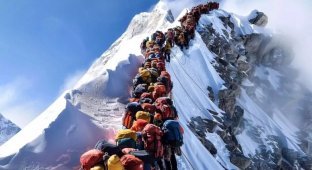Why Everest and not Chomolungma? (8 photos)
Anyone who studied geography at school will easily remember the name of the highest peak on the planet. Everest has long attracted climbers, extreme sports enthusiasts and fans of everything mysterious. Its height has been repeatedly measured recently. Therefore, even in official materials there are three sets of numbers: 8848 m, 8850 m, 8844 m. The first of them is firmly entrenched in our memory. The last one was measured by the Chinese side. 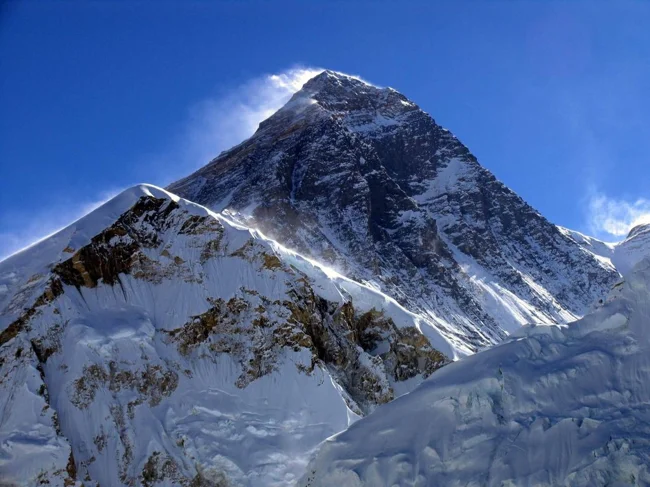
This is a difficult question, because we are talking about the height of the highest mountain on Earth. And it is very right that the interested parties have agreed to consider the height equal to 8848 meters for the near future.
Meanwhile, the highest mountain on the planet received its current name relatively recently, only a century and a half ago.
Tibetan monks have called it Chomolungma - "Mother Goddess of the Earth" since time immemorial. French missionaries, who reached the Himalayas in the 18th century, put it on the map under the name Ronkbuk - this was the name of the Tibetan monastery built on the northern slope of the mountain by order of the Dalai Lama. In Nepal, the highest mountain was called Sagarmatha - "Heavenly Peak". However, today the mountain is known to the whole world by the name that the British gave it. They gave it in honor of a man who never climbed to its summit and did not even approach it. 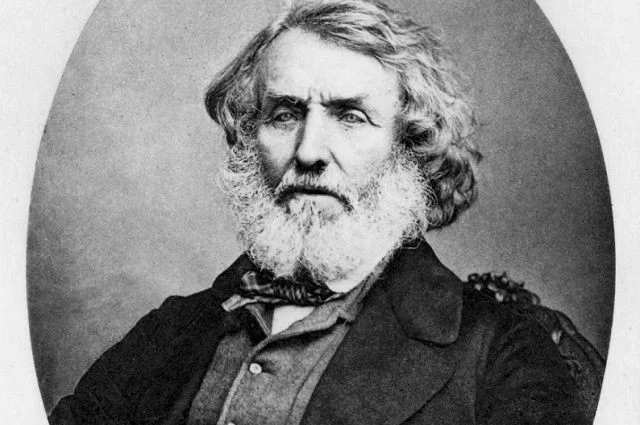
George Everest was born on July 4, 1790 in Wales, in the town of Gwernvale, to an aristocratic family. A military career was typical for boys from wealthy English families of that time, and George was no exception. After finishing school, he entered the military school in Woolwich. George was an excellent student, especially pleasing his mathematics teachers with his success. Everest graduated from the school ahead of schedule, at the age of 16, and was sent to serve in India as an artillery cadet.
Having appreciated his brilliant mathematical abilities, the command transferred the young military man to the geodetic service. In 1814, Everest went on an expedition to the island of Java, where he spent two years.
In 1816, the 26-year-old officer was returned to India, and two years later he became deputy to William Lambton himself, the head of the British survey service in India.
At this time, Lambton and his subordinates were solving a truly titanic task - conducting a geodetic survey of India. This was not only about the country within its current borders, but also about the territories on which other states have now formed, primarily Pakistan. 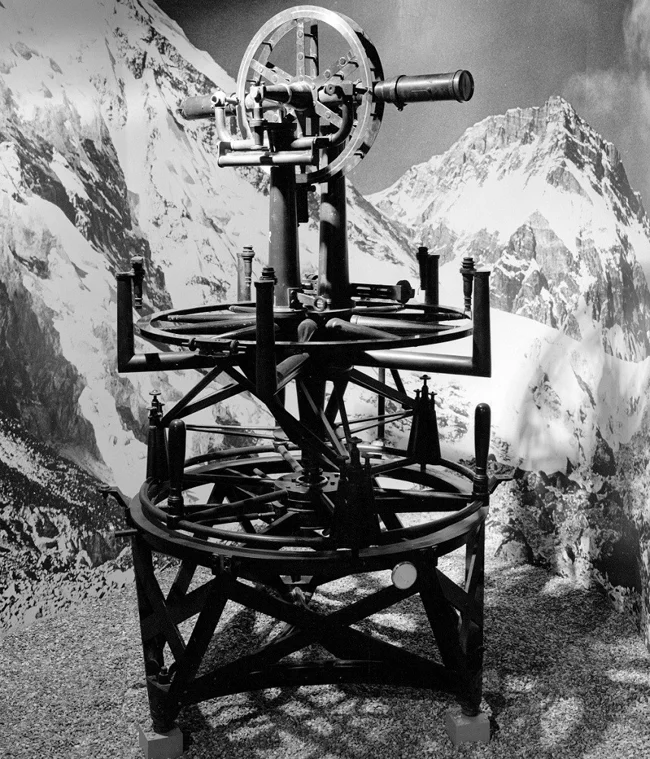
Theodolite is a measuring instrument used by George Everest
During the year, the climatic conditions on Everest are considered to be quite extreme. The coldest month is January, as the average temperature fluctuates between -36 and -60° C! But the warmest month, if you can call it that, is July, when the temperature does not drop below -19° C. An amazing fact is that the boiling point of water at the top of the mountain is only 70° C. This phenomenon is due to the pressure indicator, which is only 326 mbar. Usually in the spring and winter seasons of Chomolungma there is a characteristic westerly wind.
Only a small part of plants and animals can withstand extreme conditions. In 1924, scientists made an amazing discovery: as it turned out, at an altitude of about 6,700 meters, a jumping spider belonging to the genus of araneomorphs was found. In order to survive, the small spider has to hunt for small springtails and flies that live within 6,000 meters. But the insects, in turn, feed on lichens and some types of fungi.
As part of the expedition that took place in 1925, specialists discovered about 30 species of those same lichens. Also, in the area of 5,600 meters, scientists discovered a mountain goose. Only a few species of birds can withstand the pressure at the summit, and they use the waste products of mountain climbers as food. 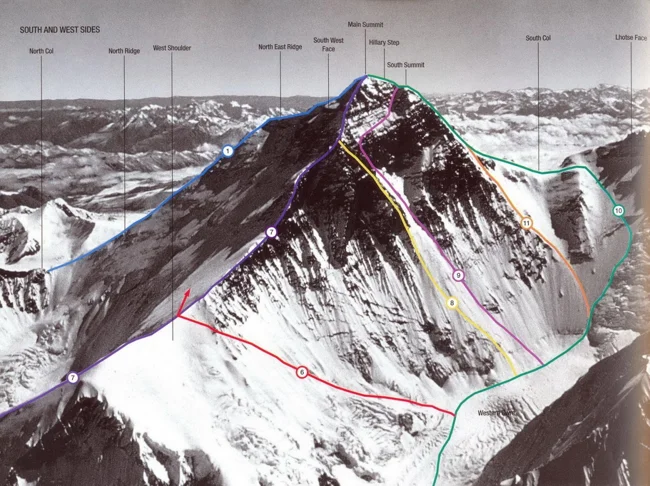
This work began in 1806 and was completed only half a century later, in 1856. George Everest spent most of his life on it.
In 1823, William Lambton died, and Everest became his successor. However, two years later he was struck down by a serious illness, forcing him to return to England.
In Britain, however, Everest continued to work on issues of the Indian geodetic service - he provided supplies of new equipment, solved theoretical problems and organizational issues.
In 1830, with his health problems behind him, George Everest returned to India, where he worked for another 13 years.
During these years, the Himalayan mountain peaks were also recorded, but their heights were not measured. All the peaks were given a code name, and Chomolungma was included in this list as "Peak XV". 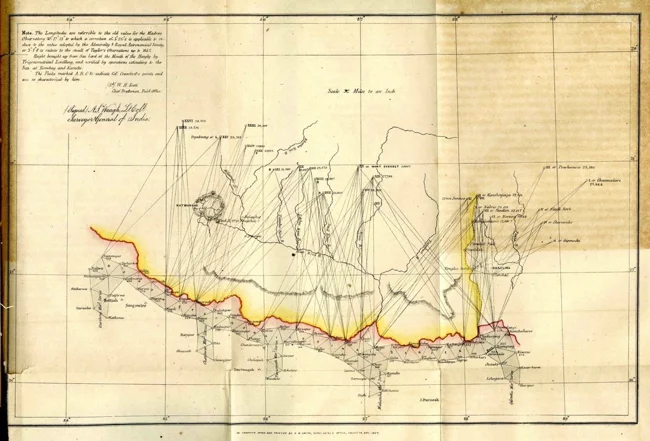
In 1843, 53-year-old George Everest retired with the rank of colonel and returned to England. Despite his advanced age, the distinguished surveyor decided to do something he had not had time for before - starting a family. It must be said that the scientist was more than successful in this, having six children.
George Everest's services to the British Empire were highly appreciated. In 1861 he was awarded the title "Sir", and in 1862 he was elected Vice-President of the Royal Geographical Society.
Having worked for many years in the surveying service in India, Everest trained a whole galaxy of students, one of whom, Andrew Waugh, worked on determining the height of the Himalayan peaks in 1852. Waugh's measurements showed that "Peak XV" is not only the highest mountain in the Himalayas, but also the highest point on the globe.
The highest mountain in the world needed a suitable name. In 1865, the English Royal Geographical Society decided that in recognition of his services to science and in honor of Sir George Everest's 75th birthday, "Peak XV" should be named after him. The first to express this idea in 1856 was Andrew Waugh, and over the next nine years the community of English scientists came to the conclusion that Sir Everest fully deserved it.
The hero of the day did not like this idea at first, but his colleagues insisted on their own. As a result, "Peak XV" first in English documents, and then throughout the world, began to be called "Everest". 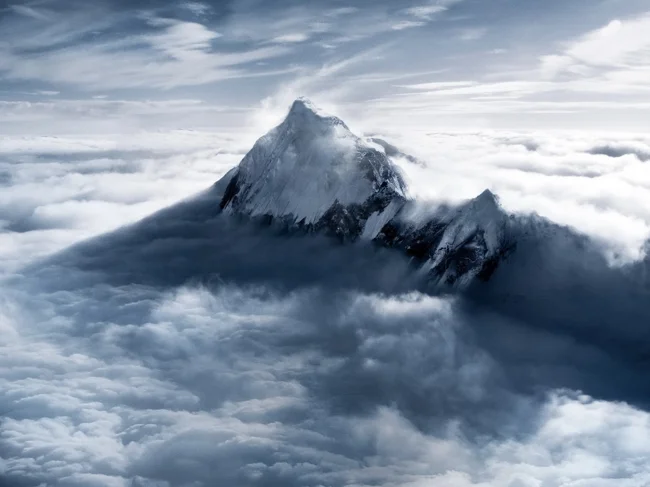
George Everest died on December 1, 1866 and was buried in Greenwich.
The memory of the merits of the scientist-geodesist remained only in specialized literature and in encyclopedias, but the name given to the peak has become so firmly established that it has supplanted all its other names.
In countries whose territory is directly adjacent to the Himalayas, in particular, in China and Nepal, there have long been proposals to return the peak to its “historical” name. Cartographers, trying to reconcile the opposing sides, suggest the following option: the entire mountain range gets the name Chomolungma, and the peak gets the double name Everest (Sagarmatha).
However, whatever one may say, for most people who do not delve deeply into such disputes, Everest remains Everest. The surname of Sir-Geodesist turned out to be too suitable for the highest peak on the planet.
It's funny that John Everest himself was of Welsh origin and called himself Ivrist. But the mountain in English transcription was immediately called Everist. For the whole world, which does not speak English well, it was called Everest... which, with a certain stretch, can be called "always resting". Again, it is interesting that George himself had the nickname "Neverest" - "never resting".
It should be noted that Everest himself took part in a meeting about names in 1857 and spoke out against the use of his name. In his opinion, the name does not correspond well to local languages and cannot be adopted by the natives. 
On May 26, 1953, the first attempt was made to climb the inaccessible Everest, but Charles Evans and Tom Bourdillon, members of the British expedition, did not reach the summit by only 100 meters! The reason for this was an acute lack of oxygen. But a few days later, on May 29, Edmund Hillary and Tenzing Norgay conquered the inaccessible mountain. The climbers did not stay at the summit for long, they managed to take a few photos and buried a cross with a couple of chocolates in the snow.
Since Everest is the highest mountain in the world, tourists and climbers from all over the world gather at the foot of the mountain to make a difficult climb and conquer the inaccessible slopes of Chomolungma. Thanks to the many years of experience of professionals, there is a large set of safe routes. There are two most popular routes: following the Northern Ridge from Tibet and the South-Eastern Ridge from Nepal. The latter is considered technically easier, so it is recognized as the most popular among beginners.
The majority of ascents to the highest mountain in the world occur in May, and all because at this time there are no strong gusts of wind. Also, October and September are very favorable months, but a large amount of snow formed after the monsoons slightly complicates the ascent. 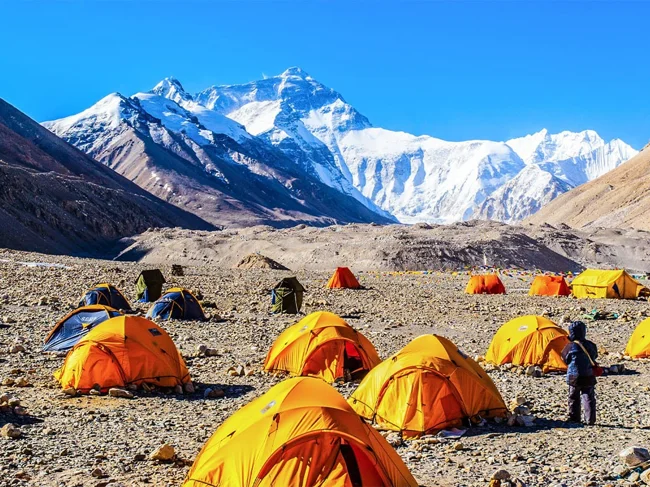
Camp at Everest









